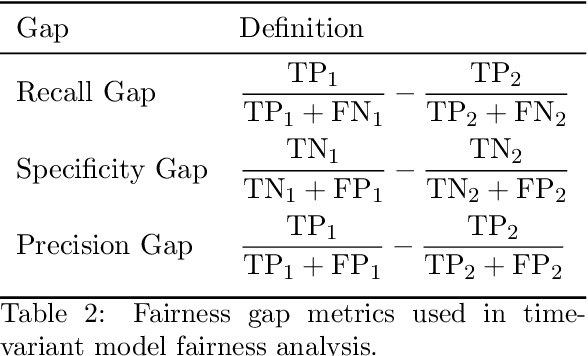Tony Y. Sun
Assessing Phenotype Definitions for Algorithmic Fairness
Mar 10, 2022



Abstract:Disease identification is a core, routine activity in observational health research. Cohorts impact downstream analyses, such as how a condition is characterized, how patient risk is defined, and what treatments are studied. It is thus critical to ensure that selected cohorts are representative of all patients, independently of their demographics or social determinants of health. While there are multiple potential sources of bias when constructing phenotype definitions which may affect their fairness, it is not standard in the field of phenotyping to consider the impact of different definitions across subgroups of patients. In this paper, we propose a set of best practices to assess the fairness of phenotype definitions. We leverage established fairness metrics commonly used in predictive models and relate them to commonly used epidemiological cohort description metrics. We describe an empirical study for Crohn's disease and diabetes type 2, each with multiple phenotype definitions taken from the literature across two sets of patient subgroups (gender and race). We show that the different phenotype definitions exhibit widely varying and disparate performance according to the different fairness metrics and subgroups. We hope that the proposed best practices can help in constructing fair and inclusive phenotype definitions.
Exploring Gender Disparities in Time to Diagnosis
Nov 15, 2020



Abstract:Sex and gender-based healthcare disparities contribute to differences in health outcomes. We focus on time to diagnosis (TTD) by conducting two large-scale, complementary analyses among men and women across 29 phenotypes and 195K patients. We first find that women are consistently more likely to experience a longer TTD than men, even when presenting with the same conditions. We further explore how TTD disparities affect diagnostic performance between genders, both across and persistent to time, by evaluating gender-agnostic disease classifiers across increasing diagnostic information. In both fairness analyses, the diagnostic process favors men over women, contradicting the previous observation that women may demonstrate relevant symptoms earlier than men. These analyses suggest that TTD is an important yet complex aspect when studying gender disparities, and warrants further investigation.
 Add to Chrome
Add to Chrome Add to Firefox
Add to Firefox Add to Edge
Add to Edge